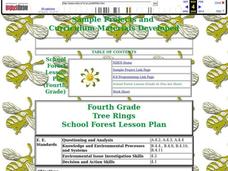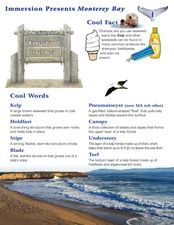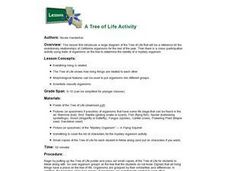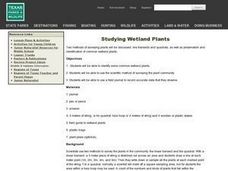Curated OER
Tree Rings
Fourth graders explore tree rings. In this plant biology lesson, 4th graders construct a KWL chart on tree rings and examine real tree rings. Students identify the changes that happened during the tree's life and its actual age. Students...
Curated OER
Forests of the Sea
Students read about and conduct experiments to learn about the vegetation under Monterey Bay. In this Monterey Bay instructional activity, students read about and look at brightly colored pictures of the different types of seaweed that...
Curated OER
Let it Grow!
Students explain the relationship of plants and animals in the environment. They name the basic requirements for plant growth and define the terms photosynthesis, stomata, chlorophyll and xylem.
Curated OER
Lichens as Air Quality Indicators: A beginning lichen identification study (2003
Students use GPS and trees to explore lichens and air quality.
Curated OER
Create a Field Guide of Local Plants
Students become familiar with making herbarium specimens as well as utilizing field guides to help identify the species which they gather. They use their herbarium collection to create personalized field guides with plants in their...
Curated OER
Looking Inside Cells
Seventh graders analyze and identify the role of the cell membrane and nucleus. They create flash cards to help them review cell structures. They also compare plant and animal cells.
Curated OER
Dichotomous Key for Identifying Pine Trees
Middle schoolers identify the species of pine trees that are found in their area. They use unlabeled "mystery" samples and a dichotomous key to identify the pine trees to species. After identification, they use a field guide to answer...
Curated OER
BioKeys
Students identify insect (and plant) specimens using the online resource Biokeys. They record the data that they collect in their notebooks. Students use identification characteristics and features that are shared and unique among groups.
Curated OER
Flowera of the Prairie
Young scholars with severe disabilities view pictures of flowers in a scanning box and identify them. Outside, they locate flowers on the school's property, label and care for them. Students use flower pictures to aid identification.
Curated OER
In the Wild
Third graders examine the concept of ecology and how animals are suited to their habitats. In this animal adaptation instructional activity, 3rd graders identify a variety of plants and animal species that live in a Beech forest.Students...
Curated OER
Hopi Agriculture
Students discuss the farming practices of the past and present of the Hopi people and discuss the importance of corn. For this Hopi agriculture lesson plan, students also plant their own seeds of corn.
Curated OER
A Tree of Life Activity
Students solve a mystery of the identification of a unknown organism by comparing its morphological characteristics to those in a tree of life classification poster. They compare the observable characteristics of the specimen and...
Curated OER
Tree Leaves: Determining the Characteristics They Share in Common
Students use their basic knowledge of dendrology concepts and terms. In this tree leaf lesson students divide into groups and determine which characteristics go with what plant.
Curated OER
Dinosaurs 1: Where Are the Dinosaurs?
Students explore dinosaurs. In this dinosaur identification lesson, students watch video clips for different dinosaurs from the Discovery Kids website. Students discuss the clips with their teacher. Students may then role play the...
Curated OER
What's Dancing in the Water?
Students learn about watershed, as well as the different forms and uses of water. In this water forms activity, students brainstorm water sources and uses. Students read the book Water Dance and discuss water examples. Students complete...
Curated OER
Campus/community Weed Pull
Students practice field identification of exotic invasive species. They use their identification key, and invasive plant species flash cards to identify and dig up exotic invasive species in a preselected
area as a community service.
Curated OER
Loco for Cocoa
Sixth graders explore agriculture by viewing food related videos in class. In this chocolate identification lesson, 6th graders discuss the healthy aspects of pure cocoa and the history of the plant. Students read assigned text about...
Curated OER
Name Match: Plants
In this name match worksheet, pupils match up fourteen different types of plants to their formal names by drawing a line from one to the other.
Curated OER
Logs of Straw: Dendocronology
Students investigate the age of trees by analyzing tree rings. For this dendocronology lesson, students examine sample images of tree rings and identify their age by the amount of rings. Students complete a chart identifying the age,...
Curated OER
Studying Wetland Plants
Students identify some common wetland plants. they use the scientific method of surveying the plant community to record accurate data that they observe. they cut a sample of each plant and save in plastic bags to identify and preserve...
Curated OER
Tagging Race
Students examine and identify plant parts to recognize specific weeds, identify three different weeds, discern differences in weeds quickly, evaluate classmates' weed recognition, and discuss what strategies they used to identify weeds.
Curated OER
Environment: Mealworm Observations
Students observe plant and animal growth and participate in class discussions about the subjects. They also record their observations in a log. Using observation and the scientific method, they describe the characteristics of mealworms.
Curated OER
Habitat Unit - Day 2
Learners explore abiotic factors that affect habitats. After a class lecture, students work in groups to answer questions about plant tissue, production and growth. They share answers, complete a crossword puzzle, and create a habitat...
Curated OER
Language Arts: Ode to the Ordinary
Eighth graders select ordinary objects, determine their uses, and write poems about them. Once they select an object, they create a web about its uses to serve as an outline. Once they have written their own odes, 8th graders meet in...

























